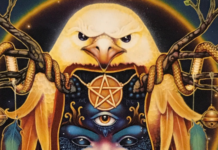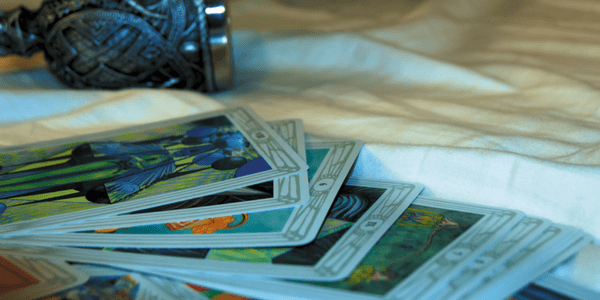 Reading tarot is a common practice in occult and Pagan circles. No matter what path you follow, the art of tarot reading finds its way into a wide range of them. All kinds of people read tarot, but the image of a “gypsy”1 telling fortunes of future persists. It’s time we lay that image (and the racism associated) to rest as tarot is so much more.2
Reading tarot is a common practice in occult and Pagan circles. No matter what path you follow, the art of tarot reading finds its way into a wide range of them. All kinds of people read tarot, but the image of a “gypsy”1 telling fortunes of future persists. It’s time we lay that image (and the racism associated) to rest as tarot is so much more.2
The art of tarot has been used most famously for the purpose of divining the future, but this is only one of its many uses and not everyone wishes to look into what’s coming up in the days, months, or years ahead. Yet, tarot can still be a useful tool of discovery in many ways including, helping to make decisions, introspection, and even working a little bit of magick now and then.
What is tarot?
Before we dive into what you can use it for, it’s important to know more about tarot. First and foremost, tarot is not a definitive look at what is to come. It is a way to see the energy surrounding a situation. Sometimes that energy is positive, sometimes it is negative, but either way, you are still in control of it.
Most people are familiar with the practice of tarot: the use of a specialized deck of 78 cards to divine information. By learning how to interpret each card and how they relate to each other, readers can find out a wealth of information. Sometimes readers use specially-designed card layouts called “spreads”.
There are many decks, all of which have their own imagery and themes so that those who are interested can find one they feel connected to. Anyone can practice tarot, from any walk of life or belief system. All you need is a deck and the desire.3
There is a superstition or belief that people should not read for themselves, but this is not something that anyone should be compelled to follow. Some people do not like to read for themselves and that is fine! If you want to use tarot as way to explore your own life, feel free to do so.
Tarot for meditation
One of the most basic things people can and do use tarot for is meditation and focus. This is usually done by pulling only one card and using it as a focus card. This method is great for people who don’t really “know” tarot because they don’t have to worry about anything complex in the meaning. For these simple one-card meditation draws, readers can refer to the book that came with their deck (or even online sources) for the meaning behind the card and use that to guide them.4
Some people like to do these one-card draws in the morning to act as a focus for their day. A card may serve to remind them to relax when in a stressful situation, or to work hard when they feel like giving up on something.
Sometimes people draw cards to use as a focus for their own meditation practice. They can use the image on the card itself, and some decks are designed specifically for this purpose, for they bear art which provides a strong meditation focus.
Another way is to use it to focus and explore aspects of our own personality and inner selves. The cards are full of archetypes and the random nature of drawing them can help us open up to different parts of our own psyche. The consistent draw of the same or similar cards may even prompt a reader to look closer at why they are drawing the same card over and over again, thus encouraging a great deal of learning
The daily draw/focus method is a great place to start for people who are new to tarot, because it doesn’t take a great deal of knowledge about the cards in order to incorporate it into a practice. It will also help those interested in tarot to better understand the cards.5
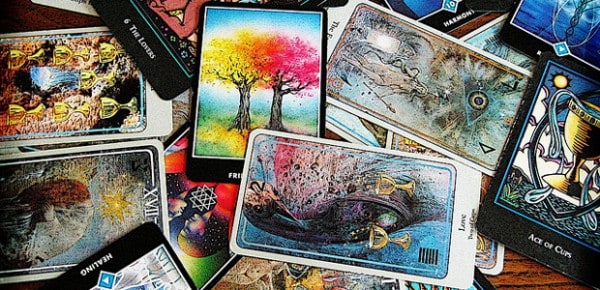
Decision making
Another really easy way to use the cards is for simple decision making. Again this only takes one card at a time at the most basic level. It’s like flipping a coin, but with the possibility of a bit more information. If faced with a “yes” or “no” choice, simply draw a card. You can find the “yes”/”no” correspondence online6 but it’s usually fairly simple to tell if a card is positive or negative, as far as your answer goes.
If you want to practice, you can even read your “yes” or “no” card as a one card pull for divination. Check out the meaning of the card and compare how it may relate to your own situation. For example, you may ask if you should go on vacation with your family next month and pull the Ten of Cups, a very positive card! In addition to the “yes”, the card also reveals that it is the time to celebrate those bonds and allow your family to share positive and fulfilling emotional connections.
If you are more comfortable with using tarot (even if you still need a book!) then feel free to do a simple spread. Even two or three card spreads can give you a wealth of information about a hard choice, including a new perspective on it.
In this way, tarot isn’t saying, “In the future this is the choice you will make”, it is simply showing you the subtle energy around your question. For example, you may ask, “Should I take this job?” You may pull the Four of Cups which is a “yes”, but it also indicates there may be other options.
Using tarot this way, gives us a system in which to explore our options beyond what is urgently presented while still giving us guidance to make a choice. Reading for decisions helps us to calm our mind and create space for further reflection on things that trouble us.7
Self-discovery and reflection
Doing a single card draw is a good start and may be all some people need, but getting a little more tarot knowledge under your belt will allow you to explore your own mental landscape more thoroughly. Once you’ve become comfortable with the cards, you can use tarot to question your motives and world around you. It provides a blueprint of what is going on in your life so that you can “see” it. In other words, tarot can act like a mirror for our own struggles.
If you’re having a hard time with something in your life, for example, a relationship, finding motivation, or feeling blue, you may find taking time to give yourself a reading can provide you a moment to reflect and sort out your own feelings.
Using the cards in this manner takes a bit more practice. If you are new and attempting to read a spread that has more than three cards, this could cause frustration which, of course, is the opposite of what you want to achieve. With more than three cards, the connections and readings get more complex, making it difficult for new readers to work with. However, if you are comfortable with your deck, you’ll be able to pick up small connections and symbols that relate back to your life.
Let’s say you’ve started a new job but you feel overwhelmed and stressed even though you’re making good money. Laying out a small spread and asking, “Why am I so stressed?” can help provide some answers. Perhaps the Fool will come up, indicating that it’s due to the newness of the position, or the Five of Wands, showing that there is some tension (perhaps with new coworkers). It can however reveal something completely different. Maybe you’ll get the Four of Wands which points towards the home, for example.
As you can see from these quick examples, there was no “fortune telling” involved, only the use of cards to guide your own reflection of your own life. This is a good way to clear your mind when going through a difficult time, or gain perspective on a complex situation.
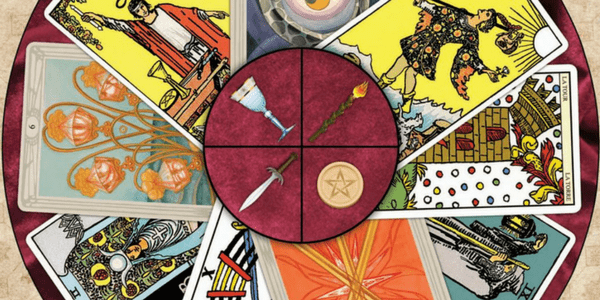
Magical correspondence
Tarot decks are full of all types of imagery, and magick work takes all sorts of ingredients. Many times we don’t have everything we need. We can use tarot cards to stand in for these. You probably don’t want to use them with any work that will ruin them, but rather for work where you just need an element present; they make a perfect stand in.
There are many cards that feature the four elements and can be substituted for times when you aren’t able to have physical fire, water, or earth. There are many animals featured on the cards which can stand in for feathers, teeth, or fur. The Ace of Swords can easily stand in for a knife, for a spell that calls for a symbolic cutting.
Intangible things can also be substituted with tarot cards. The Divine Feminine and Masculine can be represented by the Empress and Emperor, for example. Emotions can even be represented by cards as well as what you hope to manifest with your spell work.
In order to use them in this way, you must be familiar with the cards as you will need to know what is in a deck before you decide to place them in your magick work. This can really help to expand your practice as you will have on hand a variety of options for substitution if you realize you’re missing something you need.
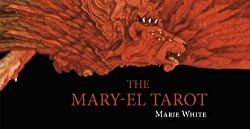 A note about this sort of use
A note about this sort of use
Rider Waite Smith (RWS) decks are more suited to this as they have greater variety of art on the cards while Thoth-based decks tend to have less on the minor arcana. A solid deck for this sort of use is the Modern Spellcaster’s Tarot as it was designed in part for this. Other strong decks for this would be the Mary-El Tarot8 and Tarot of the Sweet Twilight as they feature a wide variety of art.9
Do tarot for your own reasons
These are just a few reasons (outside of fortune telling) that people do tarot readings, but it is not an exhaustive list. Tarot as a skill, once learned, can be applied to whatever you want to use it for. Some people use it to help others, some use it to inspire their creativity. Perhaps you will use it for something else entirely.
- The word “gypsy” is actually a slur against Romani people. [↩]
- Alexa Vagnozzi, “Why ‘Gypsy’ Is A Racial Slur,” Odyssey, 2016. [↩]
- For more information on buying a deck, check out this primer from Donyae Coles, “How to buy a tarot deck.” [↩]
- An easy source is here: “Tarot Card Meanings,” Paranormality, 2017. [↩]
- See also Baird Stafford’s article, “Divinatory meanings of the tarot.” [↩]
- Here’s one website to check: “Genuine Tarot Reading – What Tarot Cards Mean Yes Or No,” Yes Or No Tarot Readings, 2017. [↩]
- See also Psyche’s article, “Can tarot make decisions for us?“ [↩]
- “Mary-El Tarot,” Mary-El.Com, 2017. [↩]
- See also Brendan Meyer’s article, “Magical correspondences and social values.” [↩]




